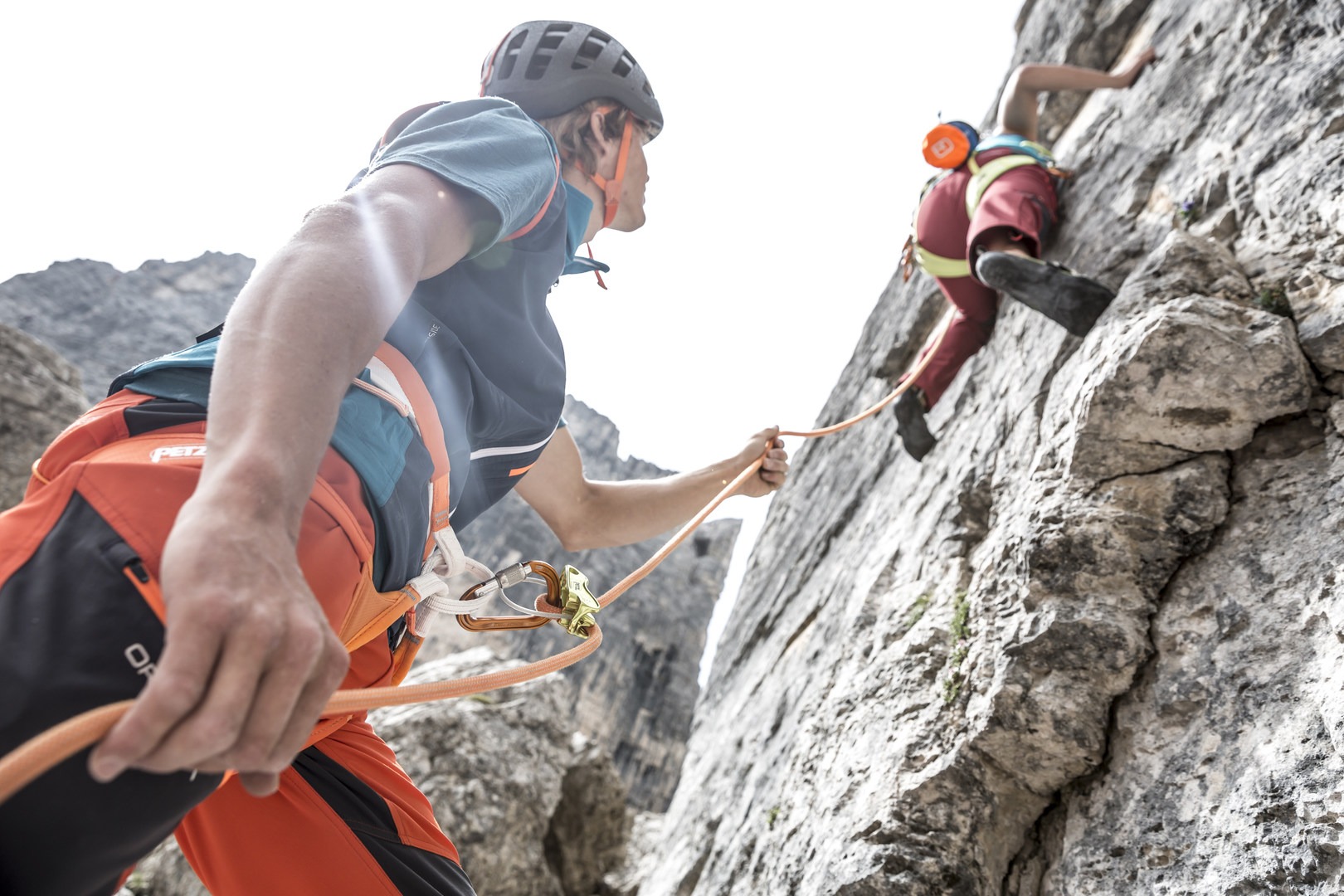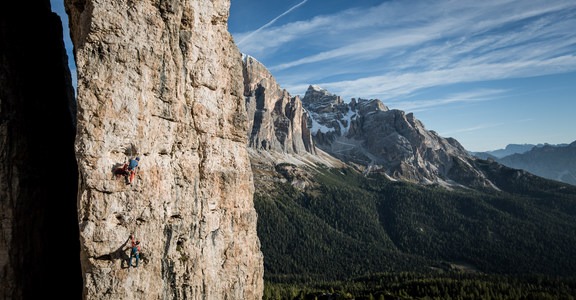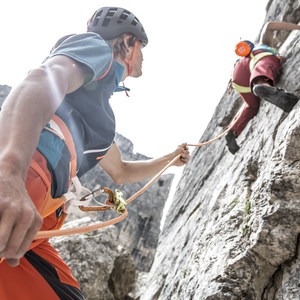Tour planning
A perfect route on a mighty rock face will stay with you forever: the most daring climb on a fantastic slope aspect with solid rock. But just like any alpine climbing objective, it requires good, thorough planning in advance.
Carefully considered and realistic route planning is an essential part of alpine climbing, whether for barely protected alpine classics or well bolted multi-pitch climbs. Only then can you safely master alpine routes, recognize danger in good time and avoid serious mistakes.
A good plan is made up of several different factors. In this chapter, we will gradually introduce you to these factors: from choosing the climbing route and difficulty level to checking the weather and the area, from scheduling to interpreting a topographic map and correctly packing your climbing backpack.
Conditions and terrain
Various aspects are taken into account when selecting and planning a route destination. Your own climbing abilities and those of your rope partner are just as important as assessing the conditions, ensuring adequate information, appropriate scheduling and the right equipment. Good planning and having enough experience to recognize potential hazard points are the foundation for your safety.
The following 10 steps are important tips to consider when planning a climb. Of course, they are not set in stone and will need to be amended or adapted depending on the route and rope team.
- Choose the right rope team - Choose the difficulty of each route based on the weakest person in the rope team. Only then can you master an alpine climb safely and in the planned period with sufficient reserve. If you are in a team of three, there are additional aspects of route planning to bear in mind: Due to the length and course of different climbs, not all alpine routes are optimally suited for teams of three. For example, long traverses such as the “Nasenquergang” traverse on the west face of the Totenkirchl (Wilder Kaiser) or the 90-meter-long exposed traverse in the Ciavazes (Sella group) do not provide ideal conditions for a team of three.
- Judge the weather properly - Checking the weather is extremely important in alpine climbing. Is there going to be a storm on the day of the climb, and will the temperature drop? Is precipitation or strong wind forecasted? The date of the last precipitation may also be crucial: On north-facing rock faces or in chimneys/dihedrals, the rock often remains wetter for longer. In spring, melted snow from above can also run into the rock face, meaning that it will not dry out for quite some time. In addition to the online weather forecast and your own weather observations, reliable sources such as local mountain guides, shop owners or local climbers are helpful contact points for obtaining information.
- Select a suitable region - A rope team should decide on a suitable region and route based on the conditions and the weather. The journey to the destination and the travel time, as well as the duration of the approach and descent, are all important parts of planning. In unfamiliar regions, it is useful to obtain an Alpine Club map or an appropriate map of the region. NOTE: There will be different types of rock depending on the region. These variations are a crucial factor in determining the type of climbing and each therefore presents new challenges.
- Select a route and find information - Your selection of a suitable route must take into account your own climbing skills and mental abilities as well as those of your rope partner. You will need to consider not only the difficulty of the route, but also its seriousness as well as the total length including the ascent and descent. Information about the route can be found in a climbing guidebook. This will provide information about the climbing difficulty, route finding, the length, the seriousness (safeguards) as well as the approach and descent. In addition, climbing guidebooks will also contain topographic maps, which provide important information about the route with standardized symbols. Both climbers in a rope team should always have a topographic map at hand when on the rock face.
- Finding further information - The rope team will usually be able to find all the important information about a route in the appropriate guidebooks: from the travel time to the approach and descent to the description of each pitch. If the climbing guides used are old or missing information, local climbers or mountaineering schools can be important contact points. Good online climbing forums can also provide information on current conditions.
- Proper scheduling - A good schedule of the entire alpine activity is essential. However, the schedule you established during your route planning will only help if you factor in sufficient buffer in advance and meet the intermediate goals you set. In an emergency, the rope team must stop and turn back in good time. As a rule of thumb:
- Approach: 400 – 500 vertical meters per hour
- On level ground: 5km per hour
- Climbing time per pitch: 20 – 30 minutes
- Rappelling: 5 – 6 pitches per hour
- Descent: 600 vertical meters per hour
- Define an alternative destination and determine a retreat option - In the mountains, various factors have an impact on whether or not a rope team can climb a rock face or not, including problems in route finding (approach), wet rock or congestion caused by too many rope teams. Alpine climbers therefore always need an alternative destination! Sensible alternatives are easily accessible and are not more difficult than the planned climb. A rope team must also have a Plan B in place once on the rock face itself. It is reassuring to know that a route can be rappelled in an emergency or that the possibility of stopping has been factored in.
- Check equipment and pack backpack - After carefully planning a climb, the rope team will know what needs to go in their backpacks. It is important that each climber only takes what is absolutely necessary and required to ensure safety. If you will be climbing an alpine rock face for several hours, you will move more quickly and easily without additional weight. When packing a backpack, climbers should prioritize optimal load distribution, so that the backpack’s center of gravity is close to the body. Equipment check: Each person checks the integrity of their own equipment as well as their partner’s
- Inform a third party of your climb and destination - If a person or rope team goes missing, it is very helpful to know which route the missing persons took. In some alpine huts, climbers and mountaineers are asked about their destination summit the evening before.
- Comparison of plan with actual conditions - A rope team can get an overview of the route even well before getting started. It is only possible to identify the route and access to the rock face from a distance. If you are directly in front of it, you will no longer have an overview of the entire rock face! In addition, it is important to check the weather and the conditions locally: How much has the weather changed despite the good forecast? What condition is the route in? A rope team needs to be able to decide and react flexibly based on the conditions they find. This is referred to as rolling planning.
Check out the full series of Safety Academy Lab Rock videos below:
- Alpine basics
- Basic equipment for every climber
- Basic equipment for groups
- Additional equipment for groups
- Storms in the mountains
- Types of rock in the Alps
- Tour planning for alpine climbing
- Packing a backpack correctly
- Rope team procedures
- Knot techniques
- Belay using bolts
- Belay methods
- Anchors
- Coiling a climbing rope
- Rappelling
- What to do in an alpine emergency
- First aid on the mountain
- Rescue techniques while alpine climbing
- Bivouacking in an emergency situation
Visit ORTOVOX’s Safety Academy Lab Rock to view the climbing tutorials in their totality and test your knowledge with their fun and interactive quizzes.
Since the company was founded in 1980 in the south of Munich, ORTOVOX has stood for the highest possible protection during alpine activities. As pioneers in the avalanche safety field, we have played a key role in the development of emergency equipment for the mountains. Innovations such as the double-frequency avalanche transceiver and Smart Antenna Technology, and also targeted training measures, continue to be valuable contributions to making mountain sports a little bit safer and to saving lives.






Comments
Sign In and share them.